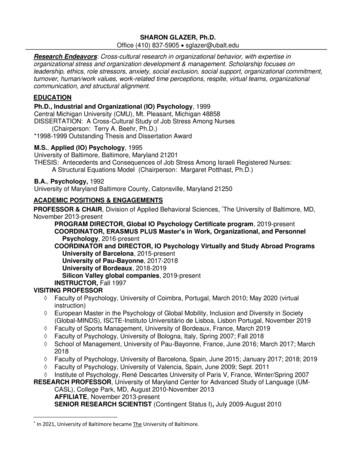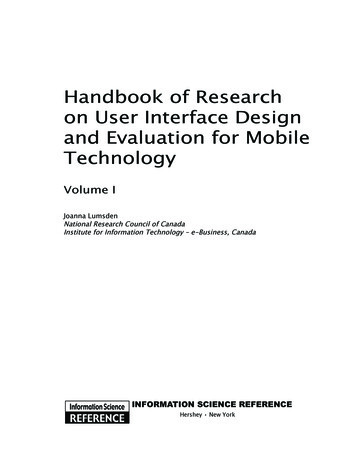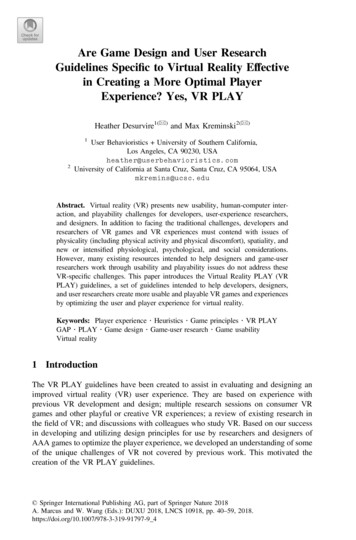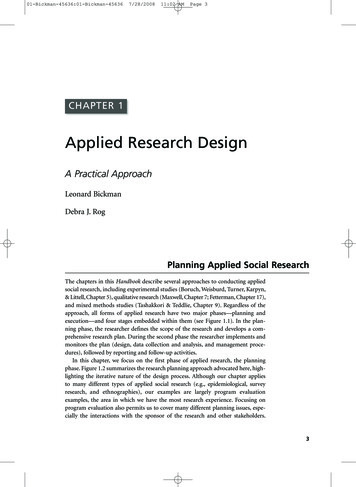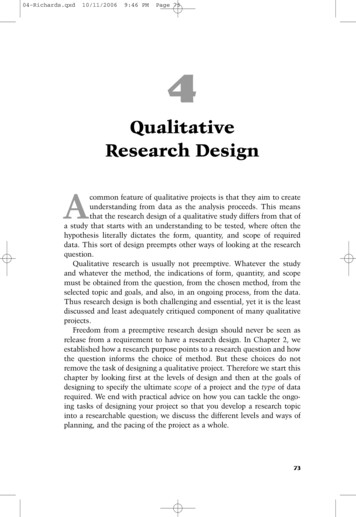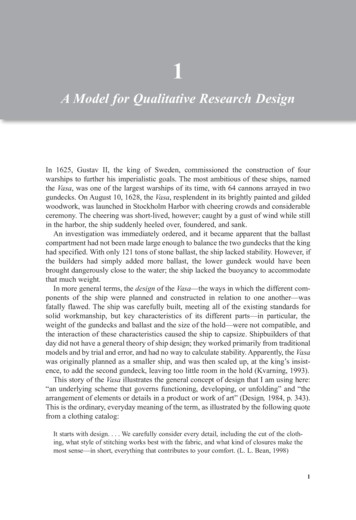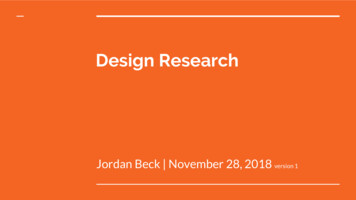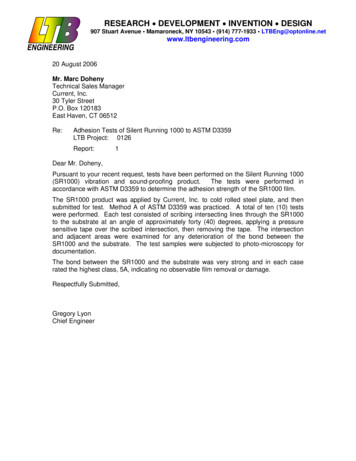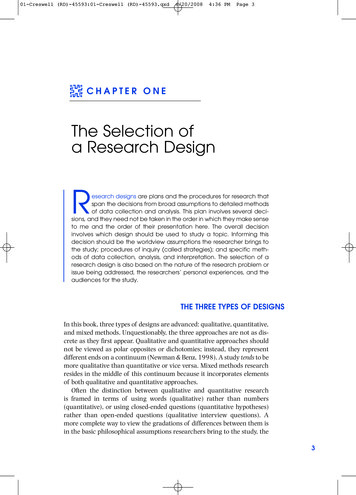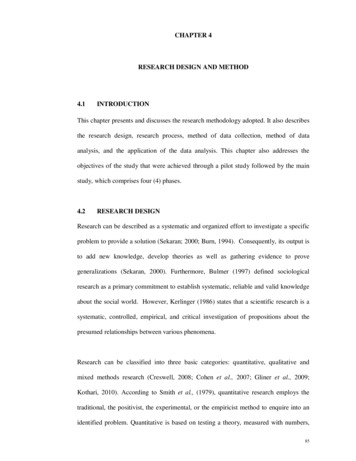
Transcription
CHAPTER 4RESEARCH DESIGN AND METHOD4.1INTRODUCTIONThis chapter presents and discusses the research methodology adopted. It also describesthe research design, research process, method of data collection, method of dataanalysis, and the application of the data analysis. This chapter also addresses theobjectives of the study that were achieved through a pilot study followed by the mainstudy, which comprises four (4) phases.4.2RESEARCH DESIGNResearch can be described as a systematic and organized effort to investigate a specificproblem to provide a solution (Sekaran; 2000; Burn, 1994). Consequently, its output isto add new knowledge, develop theories as well as gathering evidence to provegeneralizations (Sekaran, 2000). Furthermore, Bulmer (1997) defined sociologicalresearch as a primary commitment to establish systematic, reliable and valid knowledgeabout the social world. However, Kerlinger (1986) states that a scientific research is asystematic, controlled, empirical, and critical investigation of propositions about thepresumed relationships between various phenomena.Research can be classified into three basic categories: quantitative, qualitative andmixed methods research (Creswell, 2008; Cohen et al., 2007; Gliner et al., 2009;Kothari, 2010). According to Smith et al., (1979), quantitative research employs thetraditional, the positivist, the experimental, or the empiricist method to enquire into anidentified problem. Quantitative is based on testing a theory, measured with numbers,85
and analysed using statistical techniques and it particularly emphasizes objectivity andreproducibility (Smith et al., 1979). Meanwhile, Fraenkel & Wallen (2003) argued thatthe goal of quantitative methods is to determine whether the predictive generalizationsof a theory hold true. Thus, quantitative research is more concerned with issues of howmuch, how well, or to whom that particular issue applies. Kerlinger & Lee (2000)explained that quantitative research is deductive in nature, and that researchers makeinferences based on direct observations with the primary goal to describe cause andeffect.According to Fraenkel & Wallen (2003), quantitative research can be classified as eitherdescriptive or experimental research. The purpose of descriptive research is to becomemore familiar with phenomena, to gain new insight, and to formulate a more specificresearch problem or hypothesis. In contrast, experimental research is to test cause andaffect relationships among variables. In descriptive research, researchers do not havedirect control over independent variables because their manifestations have alreadyoccurred or because they are inherently not manipulable (Kerlinger & Lee, 2000).In contrast, a study based upon a qualitative process of enquiry has the goal ofunderstanding a social or human problem from multiple perspectives (Denzin &Lincoln, 2000). Thus, qualitative researchers deploy a wide range of inter connectedinterpretive practices, hoping always to get a better understanding of the subject matterat hand. Additionally, they also explained that qualitative research is conducted in anatural setting and involves a process of building a complex and holistic picture of thephenomenon of interest as well as being inductive in nature. A researcher also delvesinto the issues of interest in depth and detail. Mixed methods combine quantitative andqualitative research.86
The research methodology primarily comprises the research design and researchprocess, sampling design, data collection and method of analysis (Gill & Johnson, 1997;Sekaran, 2000; Ayob, 2005). The subsequent sub-sections present a brief outline of theresearch design and research process.4.2.1Research Design and Research ProcessKumar (1999) stated that a research design is a procedural plan that is adopted byresearchers to answer questions objectively, accurately, economically and with validity.A traditional research design is a blueprint or detailed plan of how a research study is tobe completed; operating variables for measurement, selecting a sample, collecting dataand analysing the results of interest to the study, and testing the hypotheses (Thyer,1993). In the most elementary sense, the design is the logical sequence that connects theempirical data, research questions and conclusions (Yin, 2002). Bryman & Bell (2007)stressed that research design should provide the overall structure and orientation of aninvestigation as well as a framework within which data can be collected and analysed.Miller & Lessard (2001), and Yin (2002) also provided detailed descriptions of theessential considerations in designing the research project. Based on theirrecommendations, the components of this research design should encompass thefollowings:i.The research problem and question,ii.Sampling design,iii.Methods of data collectionFurthermore, Yin (2002) stressed that the main purpose of the research design is to helpavoid a situation in which the evidence does not address the initial research questions.In this sense, a research design deals with a logical problem and not a logistical87
problem. In conclusion, Rani (2004) described a research design as a blueprint or a planfor action, specifying the methods and procedures for collecting and analysing theneeded information, fulfilling the research objectives, and finding the solutions.Identifying and formulating a problem is one of the most important aspects of doingresearch in any field. Research cannot proceed until a problem is recognized (Rani,2004). The research problem serves as the foundation of a research study if it is wellformulated.A research problem may take a number of forms, from the very simple to the extremelycomplex. The formulation of a problem is akin to the ‘input’ and the ‘output’ of a study,thus, reflecting the quality of the contents of the research report and the validity of thecausation established (Chaudhary, 1991; Kumar, 1999). A problem does not necessarilymean that something is seriously wrong with the current situation or needs to berectified immediately. A problem could simply indicate an interest in an issue wherefinding the right answers might help to improve an existing situation, or to minimize agap between the actual and the desired ideal state (Sekaran, 2000). In the final stage offormulating the research problem, the general question can be transformed into a seriesof specific questions to indicate the strategic observations to answer those questions(Chaudhary, 1991).Zikmund (2000) argued that the research design is a master plan specifying the methodsand procedures for collecting and analysing the needed information and suggested fourbasic design techniques for research, namely, surveys, experiments, secondary data andobservation.88
According to Malhotra (2004), research design is a framework or blueprint forconducting the research project and it will specify the details of the proceduresnecessary for obtaining the confirmation needed to structure and solve the researchproblems. Furthermore, Malhotra (2005) classified the research design into two broadcategories – exploratory and conclusive research, where the objective of exploratory isto provide insights into, and an understanding of the problem confronting theresearcher, and conclusive research is designed to assist the decision maker indetermining, evaluating and selecting the best course of action to take in a givensituation. The research designs for this study were based on exploratory and conclusiveresearch.The research process of this study was adapted and modified from the research processused by Cavana et al. (2001), as indicated in Figure 4.1. It was formulated principallybased on looking at four (4) different phases, which address the research questions atevery phase of this study. The first phase comprises two (2) parts. In Part 1 (Phase 1)the factors for customer satisfaction for IBS houses were determined through a literaturereview and pilot study. In Part 2 (Phase 1) the factors for success and barriers to IBSadoption in the construction industry were also determined through a literature reviewand pilot study. Then, both factors were collected through quantitative study using aself-administered questionnaire survey.In the second phase, both customer satisfaction factors in Part 1 and the IBS adoptionfactors in Part 2 were separately set as the requirements or “What’s” in the QFDapplication. Through qualitative study or focus group discussion, as the data collectionmethod, both requirements were analysed and examined using QFD application in orderto determine the strategies to fulfil both requirements.89
The third phase of the research process combined the customer satisfaction strategiesand the IBS adoption strategies determined from the second phase, and, further set asthe new requirement or “What’s” for another stage of QFD application. The objectivefor combining both strategies was to determine which organizations are supposed to actin order to implement full IBS adoption in the Malaysian construction industry.The fourth phase of the research process validated the entire research process, researchfindings and the research contributions for content validity, as defined by Cavana et al.(2001). Content validity ensures that the measures include an adequate andrepresentative set of items that tap the concept. There are at least three ways to achievecontent validity, namely, from the literature, from qualitative research and from thejudgement of a panel of experts. The validation process for this study was conductedthrough semi-structured interviews among professional experts – academicians andconstruction stakeholders. The research process of this study is illustrated as in Figure4.1. This figure provides the overall research process flow chart for the methodology ofthis study.90
Literature ReviewPART 1PART 2Customer SatisfactionFactorsPilot StudyIBS Adoption FactorsPilot StudyPHASE 1Data CollectionQuantitative Study(Quantitative)Questionnaire SurveyData Collection(Quantitative)Questionnaire SurveyData AnalysisData AnalysisDescriptive AnalysisGap AnalysisDescriptive AnalysisGap AnalysisCONTRIBUTIONCustomer SatisfactionFactors IdentifiedCONTRIBUTIONIBS Adoption FactorsIdentifiedPHASE 2Data CollectionQualitative Study(Qualitative)Focus Groups DiscussionData Collection(Qualitative)Focus Groups DiscussionData AnalysisData AnalysisQFD ApplicationQFD -----------------PHASE 3CONTRIBUTIONi) Q Matrix Developmentii) Customer SatisfactionStrategiesData AnalysisQFD Applicationi)ii)CONTRIBUTIONi) F Matrix Developmentii) IBS Adoption StrategiesCONTRIBUTIONQFD Matrix DevelopmentFive (5) major roles oforganizations to improve -----------------PHASE 4Validation of Entire Study(Qualitative)Structured InterviewFigure 4.1:Research Process (adapted and modified from Cavana et al., 2001)91
4.2.2Sampling DesignThe sampling design for each study will depend on the population, sampling size andmethod of analysis used. Non-probability sampling was selected in this study. Nonprobability sampling plans are more dependable than others and could offer animportant lead to potentially useful information with regard to the population (Cavanaet al., 2001). The category of non-probability sampling used in this study was purposivesampling to obtain information from specific target groups. The sampling is confined tospecific types of people who can provide the desired information, and who conform tosome criteria set by the researcher. Each study had different sample sizes, all of whichmeet the basic requirement based on the purpose of study. In the first part of the firstphase, the samples were selected from the IBS house occupiers. In the second part ofthe first phase, the samples were selected from construction stakeholders inclusive ofboth the public and private sectors within the construction industry. In the second andthird phase, the samples were selected among the IBS house occupiers and theconstruction stakeholders as the representative sample.4.2.3Data CollectionAccording to Ayob (2005); Rani (2004) and Sekaran (2000), the researcher mustspecifically set up respondents for the research – individuals, groups, and a panel ofrespondents whose opinion may be sought on specific issues. Interviewing,questionnaires, and observing people and phenomena are the three main data collectionmethods in survey research.According to Cavana et al. (2001), after the development of the research questions, dataneeds to be collected. Data can be collected by using either quantitative (example –questionnaires) or qualitative (example – focus groups) methods.92
The methods of data collection in this study, were carried out through quantitative, aself-administered questionnaire survey in the first phase of the research process;through qualitative, a focus group discussion in the second and third phase; and, finally,through qualitative, structured interviews in the fourth phase.Two sets of structured questionnaires were designed; the first set for IBS houseoccupiers and the second set for construction stakeholders, namely, clients ofconstruction projects, developers, manufacturers, consultants, contractors and others.Both questionnaires were developed based on literature surveys and further enhancedby employing the outcomes, suggestions and comments from the pilot study.The literature reviews from previous studies from sources, namely, journals, books,conference papers, proceeding papers were conducted. The objective is to determineand examine the factors of customer satisfaction and IBS adoption. The data collectedfrom the questionnaire survey were analysed using descriptive, and gap analysis. Thedata collected from the focus group discussion were analysed using QFD application.Finally, the data collected from the structured interviews were analysed usingdescriptive analysis (percentage).Upon identifying the research methodology, research design and sampling design, asproposed by Leedy & Ormrod (2005), and Cavana et al. (2001), data collection wasthen planned for the quantitative and qualitative study. The entire data collection of thisstudy survey was conducted between June 2009 and February 2010. The data collectionprocess covers the pilot study, and the two main studies – quantitative study andqualitative study.93
4.2.4Method of AnalysisThis section discusses the method of analysis for the phases of study. An appropriatemethod of analysis was selected to ascertain the output of the analysis that addressed theresearch questions through the four respective (4) phases of the study. Very specificmethods of analysis were used to analyse the data. The method analysis employed ateach phase of the study is described including the methods and justification as to whythese methods were selected. In the following sections, different methods of analysisare discussed as well as the specific method of analysis selected for each phase of thestudy.In this study, the approach of using a combination of methods of analyses was appliedin all the phases. In the first phase, frequency distribution, arithmetic measure, gapanalysis and Pareto analysis were employed to identify both the customers’ satisfactionfactors and the IBS adoption factors. However, in the second phase, which was the mostcrucial among all the phases, Pareto analysis and QFD application were used to identifythe customer satisfaction strategies and IBS adoption strategies. The use of QFDapplication was repeated in the third phase to extract the major roles of organizations inorder to implement IBS adoption in construction. In the fourth phase, the data collectedto validate the entire study were analysed according to the percentage, as proposed byCreswell (2008) and Cohen et al. (2007). Table 4.1 indicates the appropriate method ofanalysis employed for each phase of the study. The rationale behind selecting therespective method of analysis reflects the purpose for conducting each of the analyses.The software used to analyse the data collections was Microsoft Excel.94
Table 4.1: Summary of Method AnalysisPhaseMethod of AnalysisPurpose1FrequencyDistributionTo classify and display the data of respondents, companies’background (Creswell, 2008; Cohen et al., 2007)1ArithmeticMeasurementsTo present the factors evaluation (mean)(Creswell, 2008;Cohen et al., 2007)1Gap analysisTo compare between satisfaction level and importance level(Parasuraman et al.,1985; Zeithaml et al., (1991)2 and 3Pareto AnalysisA method of classifying items, events or activities accordingto their relative importance. The so-called Pareto Principle(also known as the 80-20 Rule) suggests that for manyphenomena 80 per cent of consequences stem from 20 percent of the causes (Juran & Godfrey, 2003;Le Blanc &Rucks, 2009; Bass & Lawton, 2009)2 and 3Quality FunctionDeploymentQFD is a tool that is able to ensure that the voice of thecustomer is deployed throughout the product planning anddesign stages. It provides a list of activities and a graphicrepresentation of the design deployment that allows one tosee the relationships between goals (What’s) as well as themeans to realize them (How’s), (Balthazard &Gargeye,1995)Percentage AnalysisValidation of results from the entire study (percentage)(Creswell, 2008; Cohen et al., 2007)44.3RESEARCH METHODThis current study is carried out to address the research issues and answer the researchquestions. Thus, the research method is hereby established from the research processformulated from the review of previous literature. It was performed in different phases –literature review, quantitative, qualitative and validation of the entire study. The phasesare described in the following section:4.3.1PHASE 1:QUANTITATIVE STUDYTo establish the research aims and objectives, a thorough literature study wasconducted, including both primary and secondary sources. Initially a pilot study wasconducted before specific attention was given to identify the customer satisfaction95
factors for IBS houses and the success factors and barriers to IBS adoption as the mainstudy.4.3.1.1 Pilot StudyAccording to Naoum (1998), good research practice starts with a pilot study before theactual study is carried out. This is the way to trace any discrepancies in the design of thequestionnaire. Liaw & Goh (2002) stated that a pilot study is not mandatory in researchdesign, but it is a normal practice before an actual study. A pilot study is used to testthe consistency of internal data, the reliability of the measurement scales for thevariables used in the questionnaire and to test the goodness of data (Sekaran, 2000). Inaddition, a pilot study ensures that the respondents understand the questions, makesrequired data available, and avoids misinterpretations (Naoum, 1998). In addition,several matters need to be ensured in the pilot study (Naoum, 1998). In short, a pilotstudy allows a time period to complete/answer the questionnaire; ensures clarity of thequestions and instructions; identifies sensitive questions that respondents are reluctantto answer; ensures the questionnaire has covered all important topics; ensures the layoutis clear and attractive; and facilitates consideration of the comments and suggestions bythe respondents (Bryman & Bell, 2007).In this research, the pilot study was conducted by the quantitative method, and datacollection was based on a questionnaire survey. The purposive sampling method wasemployed as the sampling method. This type of sampling method has less reliability butis preferred when the time is short, and where the information is needed quickly(Cavana et al., 2001; Sekaran, 2000). The effectiveness of each question designed wasachieved by providing the necessary information and data required through thequestionnaire. The questionnaire was designed and drafted based on the literature96
review and was distributed among 30 respondents of IBS house occupiers in the firstpart of the first phase and another 30 respondents who were construction stakeholders inthe first part of the first phase. These respondents contributed immensely by givingideas on how the questions should be restructured to achieve the maximum impact onthe respondents, and, ultimately, on the entire research study.Following the pilot survey, an important observation was made in that there was anambiguity in three of the questions. Following this observation, the questions weremodified to reflect the correct questions as intended by the researcher.(i)Testing for Instrument Reliability and ValidityThe testing for the questionnaire reliability and validity can be observedmathematically. In view of this, the questions were studied in discussion with thelearning supervisor and the responses were deliberated upon concerning their ability toanswer the investigations proposed in the research. Since no major incongruence wasfound, it was decided that the questionnaire was suitable for the intended purpose of thisresearch.An experiment is valid if it does what it is intended to do. To some extent, the two termsare indistinguishable and do have some overlaps. To establish if a questionnaire isreliable and valid we need to calculate the alpha coefficient, which is defined asfollows:2n s j 1 2n 1 sj 97
Where;Nis the number of measurement items, ss 2j2jis the sum of the variance of all the measurement items,is the variance of the total value measurementsN 2 X Y2iN i 1Reliabilit y N 1 X2 Validity A questionnaire can be reliable and valid, if both α and β are greater than 0.7. Thereliability test was conducted on the questionnaire used in the pilot study. Table 4.2shows the results of the reliability for the IBS house occupier questionnaire (First Partof First Phase), whilst Table 4.3 shows the results of the reliability of the IBS adoptionin the construction industry questionnaire (Second Part of the First Phase). From thesetables, the overall co-efficient values of Cronbach’s Alpha for both questionnaires were0.762 (Q1) and 0.712 (Q2). Since both the IBS house occupiers and IBS adoptionstakeholders achieved above 0.7 co-efficient values of Cronbach’s Alpha, the resultsshowed that all variables indicated internal consistency and achieved reliability valuesbased on the scales developed by Sekaran (2000) and Nunally (1978). Thus, the coefficient values of Cronbach’s Alpha showed that the respective respondents were ableto understand all questionnaires and they admitted the necessity for asking the questions(Bonett, 2002; Feldt et al.,1987).98
Table 4.2:Reliability Test on IBS House Occupiers QuestionnaireItemCoefficient Value -Cronbach’s AlphaNo. of items0.762132House Owners QuestionnaireTable 4.3:Reliability Test on Construction Stakeholders QuestionnaireItemCoefficient Value -Cronbach’s AlphaNo. of items0.71234Construction Stakeholders4.3.1.2Customer Satisfaction Factors of IBS Houses- Part 1 in Phase 1The first part of the first phase of the research process is to determine and examine thecustomers’ satisfaction factors of IBS houses. It is part of the research process in orderto achieve the first research objectives.(i)Sampling DesignCopper & Schindler (2008) suggested that in designing the sample, the followingshould be performed: the target population, parameters of interest, sampling frame, theappropriate sampling method and the required sample size of the sample. For thequantitative study in the first part of the first phase, the sampling was purposive(Cavana et al., 2001; Creswell, 2008), as this research intended to select respondentsamong the IBS house occupiers. The parameter of sampling interest was from thepopulation of the IBS house project. The sampling frame of this study comprised the99
house occupiers from three IBS housing projects. The unit of analysis required was theindividual.The samples were taken from the population of three (3) IBS house projects that werechosen. The sample frame involved projects of three (3) blocks of medium costapartments in Putrajaya, two-storey terrace house in Putrajaya and one (1) block of lowcost flats in Puchong, Selangor. The total population of the three IBS house projectsstudied was 1,364. The researcher used purposive sampling with a total of 391respondents responding to this research study. The total population of the three (3)blocks of medium cost apartments at Precint 9, Putrajaya was 684 units. The researchermanaged to collect (188) data from the total population equivalent to 27 percent. Thetotal population of the two-storey terrace house in precinct 11, Putrajaya was 340. Theresearcher managed to collect (102) data from the total population equivalent to 30percent. Finally, the total population of low cost flats in Puchong, Selangor was 340.The researcher managed to collect (101) data from the total population equivalent to 30percent.(ii)Data CollectionSurvey research is widely used to determine specific characteristics of groups (Fraenkel& Wallen, 2003) and measure attitudes and opinions of groups towards certain issues(Ary et al., 2002). Surveys are conducted through various methods including mail,telephone, and personal interviews based on the contents of the questionnaire, numberof subjects, budget, time available and target response rates. This research adopted aself-administered questionnaire survey method as the strategy for data collection. Toachieve the first objective, a questionnaire was designed for the IBS house occupiers.100
(iii)Design of QuestionnaireThis section will explain the issues involved in designing the questionnaire. The issuesinclude the content, format and structure. A structured questionnaire design was used inthis study. The questionnaire takes approximately 20 minutes to complete. The use of aself-administered questionnaire instead of a postal or e-mail questionnaire mayencourage people to participate in this study.According to Malhotra (2004), the advantages of a questionnaire to collect data are:i) it is simple to administer; ii) the data obtained is reliable; and iii) the coding, analysisand interpretation of data are relatively simple and straight forward. In thisquestionnaire, most of the questions are fixed alternative questions that require therespondents to select from a predetermined set of responses. A copy of the researchinstrument used in this study is shown in Appendix A and B.Itemized scale ratings, namely, the Likert-type scale was applied to most of thequestions in this questionnaire. The advantages of Likert scaling are that it is easy toconstruct and understand as well as flexible and economic in terms of space (Alreck &Settle, 1995).The main objective of this survey is to get first-hand information from the consumer’sof IBS housing occupiers regarding the current standard and conditions of the IBShouses. This is the essence of QFD application. The feedback obtained directly from theusers was based on their experiences and described in their own words.101
The questionnaire for the House Occupiers was designed in three different sections.First is the occupiers background, second is house background. The third sectionconcerns importance and satisfaction. These sections are identified as follows:a)Occupiers ii.xiv.xv.xvi.xvii.b)NameAddressTelephone l statusChildrenIncomeHouse typeHouse Built-up areaOwnership statusHouse priceReason forpurchasing houseHouse backgroundi.ii.iii.iv.v.vi.vii.c)DeveloperNumber of floorsNumber of roomsRenovation done to the houseMain issues or problemsTypes of issue and cost of renovationHouse owner’s questionCustomer satisfaction factorsThere are numerous questions in nine major areas with both importance and satisfactionanswers in the form of a 5-point Likert scale. There is a final question with an overallsatisfaction question with five answers, as follows:i.ii.iii.iv.v.Extremely dissatisfied;Dissatisfied;Satisfied;Very satisfied; andExtremely Dissatisfied102
Table 4.4: The construct of the customer satisfaction factors for the IBS houseCustomer Satisfaction FactorsSize of housei.ii.iii.2Less than 1000 m1001 - 2000 m2More than 2001 m2House pricei.ii.iii.iv.v. 0 RM300000Quality of .i.j.123456789101112k.12345Sub StructureFoundationGround FloorGround BeamSuper StructureColumnUpper FloorFloor BeamRoof BeamExternal WallInternal WallWindowDoorFinishesExternal Wall FinishesInternal Wall FinishesExternal Floor FinishesInternal Floor FinishesCeiling FinishesBuilding ServicesToiletBathroomPipe InstallationElectrical InstallationBuilt in FittingsLayout of houseMaster BedroomBedroomLiving RoomDining RoomDry KitchenWet KitchenToiletBathroomWet AreaUtility RoomBalconyPark LotsExternal WorkDrainageLandscapeGateFencingAccess RoadSourceAbdul-Rahman et al. (1999)Stehn & Bergstrom, (2002)Dikmen et al.(2005)Quantitative StudyStehn & Bergstrom, (2002)Mustafa & Ghazali (2011)Gargione (1999)MHLG (1998)Quantitative StudyAbdul-Rahman et al. (1999)Dikmen et al.(2005)Kam & Tang, (1997)Gargione (1999)Ashworth (1990), Hock (2007)Quantitative StudyAshworth (1994), Hock (2007)Quantitative StudyAshworth (1994), Hock (2007)Quantitative StudyAshworth (1994), Hock (2007)Quantitative StudyAshworth (1994), Hock (2007)Quantitative StudyAshworth (1994), Hock (2007)Quantitative StudyAshworth (1994), Hock (2007)Quantitative StudyAshworth (1994), Hock (2007)Quantitative StudyAshworth (1994), Hock (2007)Quantitative StudyAshworth (1994), Hock (2007)Quantitative StudyAshworth (1994), Hock (2007)Quantitative StudyAshworth (1994), Hock (2007)Quantitative StudyAshworth (1994), Hock (2007)Quan
Furthermore, Yin (2002) stressed that the main purpose of the research design is to help avoid a situation in which the evidence does not address the initial research questions. In this sense, a research design deals with a logical problem and not a logistical . 88 problem. In conclusion, R

